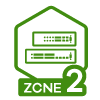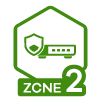How to configure VLAN for web-managed switch?
 Zyxel Employee
Zyxel Employee



Scenario:
I have a web-managed switch and I want to configure VLAN on it. I have multiple devices connected to the switch and I want to segregate the network traffic for better management and security. I am not sure how to go about it.
VLAN Concept:
VLAN(Virtual Local Area Network) is a technology that allows you to partition your network into different segments. Each VLAN is a separate network and the devices within the same VLAN can communicate with each other, but they cannot communicate with devices in other VLANs unless allowed by a router or a layer 3 switch. This helps in reducing broadcast traffic, increasing security, and better managing your network.
Within our web-managed switch, you have the capability to create, modify, and delete IEEE 802.1Q VLANs for the switch, as well as assign a Port VLAN ID (PVID) to specific ports.
When creating a VLAN, it's important to consider egress rules, which determine how the switch handles outgoing traffic, specifically whether the traffic should retain VLAN tags or not.
- While the port sets as a tag egress member, the outgoing frame will keep its VLAN ID as it moves to the next device. This is useful when you want to preserve VLAN information as traffic passes through multiple switches or other network devices that understand VLAN tags.
- While the port sets as a untag egress member, the outgoing frame does not carry any VLAN tag as it moves to the next device. This is often used when the next device in line (like a PC or a printer) does not understand VLAN tags. Usually, we pair the untagged egress member with a PVID.
Assigning a PVID to a port means you're designating the VLAN ID that will be assigned to untagged frames arriving at that port. This ensures that traffic without VLAN tags is assigned to the appropriate VLAN within the switch.
- If the switch receives frames that are already tagged, they will be classified to the VLAN group indicated on that frame's VLAN tag.
- If the switch receives frames not carrying any VLAN tag, these frames will be classified to the VLAN group indicated on the switch’s port VLAN ID.
Steps to Configure:
Here are the steps to configure VLAN on a web-managed switch:
- Access the switch's web interface.
- Navigate to the VLAN tab settings.
- Click on the "Create New VLAN" button to create a new VLAN. You will need to provide a VLAN ID, which is a unique number to identify the VLAN.
- After creating the VLAN, you need to assign PVID to it. Select the ports that you want to include in the VLAN and apply the settings.
- After configuring the VLAN, make sure to save and apply the settings. The switch will then implement the VLAN configuration.
Note: the exact steps and terms may vary depending on the model of your switch. Always refer to the user guide for specific instructions.
Kay
Categories
- All Categories
- 441 Beta Program
- 2.9K Nebula
- 210 Nebula Ideas
- 127 Nebula Status and Incidents
- 6.4K Security
- 539 USG FLEX H Series
- 340 Security Ideas
- 1.7K Switch
- 84 Switch Ideas
- 1.3K Wireless
- 51 Wireless Ideas
- 6.9K Consumer Product
- 295 Service & License
- 464 News and Release
- 90 Security Advisories
- 31 Education Center
- 10 [Campaign] Zyxel Network Detective
- 4.7K FAQ
- 34 Documents
- 86 About Community
- 99 Security Highlight


